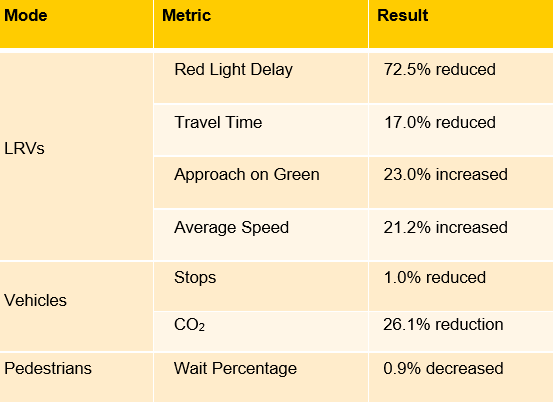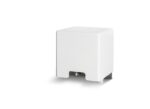
Smart simulations and sensors lead to smoother traffic flow in San Francisco
The Connected Corridor Proof of Concept (PoC) in San Francisco aimed to improve the traffic flow at the many intersections on 3rd Street. This busy corridor is home to a sports stadium and a large hospital. In addition to light rail trains, passenger cars and buses, the street is also used by many pedestrians and cyclists. This PoC is one of our most innovative mobility projects.
Improving public transport
TNL’s mobility experts and partners worked with main contractor Arcadis, the world’s leading company delivering sustainable design, engineering, and consulting solutions for natural and built assets, to deliver a solution as part of a contract with the San Francisco Municipal Transportation Agency (SFMTA).
SFMTA is the city agency responsible for all public transport in the city, including the iconic cable cars, city buses and the light rail trains of the Municipal Railway, as well as parking, traffic lights, paratransit, and the new micro-mobility solutions. Improvement of the public transport system is a key focal point for San Francisco, as is the reduction of air pollution and of the number of traffic casualties. The Connected Corridor PoC dovetails perfectly with these goals.
Previously: streetcars waiting for lights
The PoC focused on a portion of 3rd Street which has ten traffic light-controlled intersections along a stretch of 1.5 km. There are four light rail train stops. Light rail vehicles often encountered a red light just before reaching the stop. Many operational tools like network connected signal controllers, Transit Signal Priority (TSP) and signal pre-emption exist already.
The original phasing of traffic lights on 3rd Street did take into account arrival and departure times of light rail trains, but the system did not have access to real-time embarking and disembarking. It observed the arrival of the train at the stop and either extended the green light if there was time available in the cycle or wait to switch the traffic light to green after a fixed number of seconds depending on side street signal settings. If the light rail vehicle failed to pull away from the stop at the expected time or encountered any other delay, the light would potentially switch back to red before the vehicle could proceed. The result was that trains at each intersection had a chance of 37.8% of a red-light delay, resulting in 58.9s average total delay at the ten intersections, which can impact operational costs, and the customer experience.
PoC results : better flow thanks to smart traffic technology
The Connected Corridor PoC uses a wholly new concept that tries to attain the optimal situation using simulations that ensure the best adjustment between light rail trains, traffic lights and other traffic. The system sees when the doors of the train close and predicts when the light rail vehicle will arrive at the next traffic light. At that moment, a request is sent to switch the light to green. In addition, the smart system takes account of cars, bikes and pedestrians at the intersections. It assigns a priority to the various groups of traffic participants at the traffic lights and takes into account the wait times of all approaches.
The system was tested at ten intersections. As the table below demonstrates, waiting times for the light rail trains were significantly shorter. The simulations of the various intersections were harmonized to obtain optimal results, and to also benefit other road vehicles and pedestrians.

The results described: “a dramatic improvement for the light rail vehicles without observed significant impacts on other modes and approaches.”
Simulations, sensors and software
The Connected Corridor PoC uses various advanced technologies:
- Connected Signal Controllers provide each second information on all existing actuators (loops, Pedestrian Push Button, train detection systems etc.).
- LiDAR sensors use laser pulses to create an accurate image of all the traffic on and near an intersection, ten times per second. The sensors can distinguish pedestrians, cyclists, light train vehicles, buses and cars.
- FlowCube sensors use artificial intelligence to determine when the doors of the light rail trains will close. In addition, they can see how busy it is on the platforms and classify the pedestrians to predict the dwell time.
- The data from the LiDAR and FlowCube sensors form the main input for software simulations. These simulate the development of traffic flows on 3rd Street on powerful servers, thousands of times per second.
- Analyzing the 20,000 simulations per second per intersection, an optimizer takes the complete road network into account and selects the optimal phasing for the traffic lights.
- Finally, this results in action: The software sets the optimal phasing of the actual lights.
The optimizer provides the crucial intelligence for the PoC. It assigns dynamic priority to groups of road users on the intersections. A group that has been waiting for some time will be assigned a higher priority, so that no one has to wait excessively long. On the basis of the simulations, the optimizer forecasts the traffic flows during the following minute. Signals from the optimizer control the green and red times of the traffic lights. Emergency services such as ambulances on their way to the hospital and fire engines, always receive the highest priority.
Working with partners
TNL supplies the FlowCubes, designed and optimized the simulation software and the optimizer, and is responsible for providing the intelligence behind the dynamic traffic signal phasing.. The PoC was the first implementation of a real-time demand based traffic management system on this corridor. TNL worked closely together on the Connected Corridor PoC with client SFMTA and vendors Arcadis (main contractor), Quanergy (LiDAR sensors), D4 (traffic light controller), and Kittelson (evaluation).


